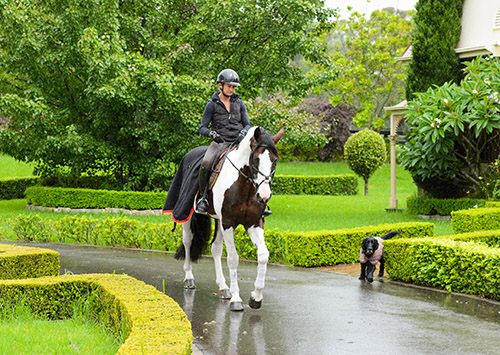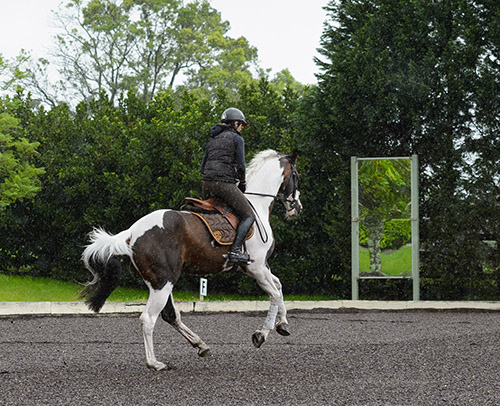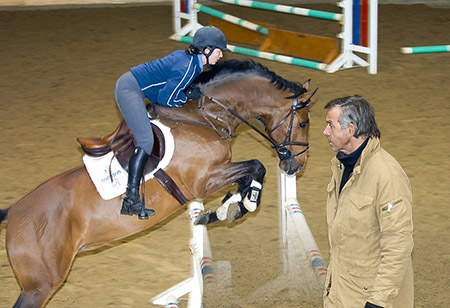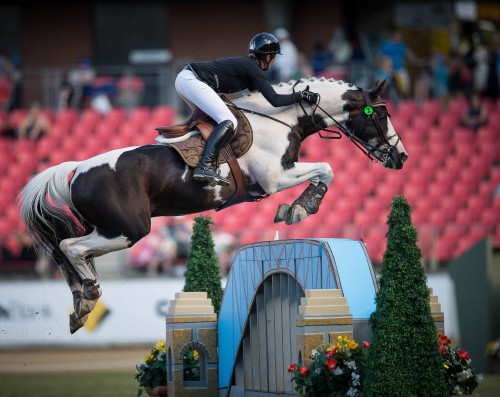Story – Suzy Jarratt
Capricious ponies and big bottomed mares sashay right past him – he watches them with tranquil eyes. This is a calm, chivalrous stallion. When the bell signals the start of a round then he will spring into action; for now Visage quietly waits.
Several years ago he suffered a shocking accident when flying home, it’s a story his owner wants to share – more of that later. Lesley Hargreaves’ Belgian warmblood originally arrived in Australia in 2003. A wonderful example of the modern sporthorse he was successfully shown by Vicki Roycroft, Lesley’s daughter Julia and by Christopher Burton. Now, ten years later, he is in the hands of young Brooke Campbell.
Originally from Sydney’s northern beaches this 29-year-old began riding when she was four on a pony of Thelwellian proportions. Small, round and often cross they are often selected as a child’s first mount, whereupon, despite the stringent rulings of the tedious OH&S, they buck off their riders on a daily basis into thistle beds and ponds.
“He was a white Shetland thing and very naughty,” she recalled, “I had a few others later including one from Horse Rescue for $300.” Even though her horses weren’t the cream of the crop she was bitten by the showing bug and while her friends were surfing, going to parties and staying up late she was getting up early to plait, polish and showjump. She became very proficient, had many successes and during these formative years earned an EFA Young Rider of the Year award.
“That was when I had Bridgford Proud Cactus who was very quick, brave and careful.”
She has learnt from Martin Gostelow, Vicki Roycroft and George Sanna and trained with internationals in Germany. She has run her own yard and managed top-class equestrian facilities for others. Now, in 2013, she has a full quota of horses on training and a large network of keen pupils – ‘and there’s not one boy among them!’
“In 2005 I was working for Martin Gostelow at Somersby on the NSW Central Coast. Norbert Boley from the Holsteiner Verband came over on a classification trip. I showed off the horses to him and he offered me a three month position over there. I needed to do it if I was to go forward as a rider.”
She had to find the air fare and she wasn’t going to be paid when she got to Elmshorn, but it was a great learning curve.
“Jive Talking paid for the plane trip. I sold him to Julia (Hargreaves). He was nothing to do with Jive Magic – he was just a stockhorse who was sacked from being a polo pony because he was crazy and would run into other horses. We took him on and jumped him and he ended up being a very good young rider horse. Julia needed a bit of confidence at the time and he was great for that.”
Brooke has never been accused of lacking confidence. Many in her early days referred to her as being exceptionally ‘gung ho’.
Commented Lesley: “She was always gifted with lots of talent but a little on the wild side. However she came back from the Verband a very polished rider.”
“I never went into a class to come second and often that would result in my pulling a rail in the jump off but that was before I went to Germany. Over there I rode a lot of horses in young horse classes and learnt it’s more important to think long term than short. Now I’m of the opinion you pick which classes you want to win. It’s fine to have a crack but you don’t go into every one to come first. At the end of the day the young horse’s education is a priority and you mustn’t gallop them against the clock too often.”
She admits that the first few weeks at the Verband were a shock to the system.
“You expect every horse to be beautifully educated – they’re not. I was learning, I was from Australia and I wasn’t paying to be there – they didn’t cut me any slack. I came through it but I think a lot of people wouldn’t have done so. I have two brothers who taught me to be tough even so, for the first month and a half, I’d cry over the phone to my mother. I had to return to Australia after three months, and when I got home they offered me a full time job – a paid one, so I got my visa and went back to Elmshorn.”
Brooke’s education blossomed.
“I trained under Margit Otto-Crepin (of Corlandus fame). She taught me how to ride on the flat and she was fantastic. I was working the just broken-in three-year-old stallions preparing them for classification which required us to trot and canter them forward and round and show off their movement. They had to travel like proper horses. These were top quality and they felt balanced but don’t get me wrong during training we were often galloping around the arena out of control!
Brooke riding at the Holstein Centre…
“I rode them at Neumunster – it was terrifying but I wasn’t alone. You’re taking these horses, who’ve never been anywhere, into a huge hall full of people who’ve come to select stallions to use for the next breeding season. There’s so much atmosphere and you just don’t know how they’ll react. The main thing they told us to do when we first entered the arena was to go forward if our horses were frightened or upset. They can’t buck, rear or get you off when they’re going forward – well not very often anyway!”
Brooke also prepared and presented them in auctions.
“We always trained and showed in ordinary loose ring snaffles with a link in the middle. If there were some which were just too strong for us then we’d put on another bit. They left the use of running reins up to us. I’m not a huge fan and they can become dangerous in the wrong hands. I think they’re a last resort when you can’t come up with any other solution. “
Not only was she learning how to ride in Germany she was learning how to speak the language.
“As well as training and presenting I was jumping at shows and having lessons with Peter Luther, a champion in his time, and he always taught me in German. Before I left the Verband, where I stayed for nine months, I was able to hold a conversation.”
At Copabella she continues to practise the language by chatting to German visitor, Max Panknin. This young dressage rider is hoping to spend more time at Copabella in the future when he will work and show some of Lesley Hargeaves’ dressage horses. He has already enjoyed some success at local events.
Upon returning to Australia Brooke’s life took a different turn – she began working as a vet nurse. She also agreed to manage Yandoo Park while Jamie Winning competed in Europe based at Stal Tops.
“I was only going to be there for six months while she was away – I stayed for almost four years, then my boyfriend and I decided to move in together and we rented a property just outside of Sydney. We felt it was time to try to make some money out of this industry. And I still work as a vet nurse twice a week at a north shore clinic.”
She and Luke Brown began Bangalow Equestrian from Oakville, on Sydney’s outskirts. French saddle company, Butet, became her sponsor, as did Coprice Feeds and Canterflex.
“Luke is an excavator, fence and arena builder plus he rides horses. He’s 24 and goes to uni at nights doing engineering finance/economics. He’s very intelligent and is in charge of all the things which I suppose I’m not very good at.”
She is very good at training, teaching and jumping resulting in Bangalow Equestrian expanding to such a degree the property just wasn’t big enough to accommodate all the clients.
“Lesley has always had horses with me and when our lease was about to run out she suggested we move to Copabella.”
Now Brooke and her bright young man are at this very stylish facility in Arcadia in north western Sydney.
“We’ve taken over looking after the existing clients and we’ve brought in a lot of our own. Copabella is at capacity and there’s a waiting list. In the next 12 months we plan to stay here although it would be nice to think that in the not too distant future I’ll be able to go back for a short stint at the Verband – I learnt more there than anywhere.
“Hopefully Visage’s competition schedule will involve doing the Queensland and Victoria runs. We’re looking forward to his having a really big year, also there are some really fancy young Visage ones coming through which is quite exciting. At the moment he’s feeling happy, strong and confident. We’ll just keep taking steps forward.”
A few years ago this stallion could barely take a step in any direction.
“We got him in 2003 when he was found by Vicki Roycroft in France,” recalled Lesley Hargreaves. “We’d asked her to look for a showjumping stallion and she called to say she’d found an amazing 5-year-old. She described him and he ticked all of the boxes and then she said ‘oh, by the way, he’s pinto’.
“I wasn’t prepared to say yes on the spot but my friend Rona von Stein said I should buy him ‘you’ll be breaking new ground’. So I did, but I don’t think I’d have been game if I’d wanted him as a dressage stallion.”
(It shoud be mentioned that this stallion’s work on the flat puts many dressage horses to shame).
Undoubtedly Visage van de Olmenhoeve, as he was known overseas, has helped to remove much of the stigma attached to coloured horses. ‘That could be by Visage’ is now heard around showgrounds instead of a dismissive ‘it’s OK but unfortunately it’s a pinto’.
The successes of this horse and those who rode him are well documented. After being with Vicki Roycroft at Mt White he was taken over by Lesley’s daughter, Julia, then moved to the family’s other equestrian property, Redleaf Lodge, run at the time by Julia and her partner, Chris Burton.
“It made sense as Redleaf is in Wilberforce close to the breeding vets at Agnes Banks. Chris took over the ride and did his very first World Cup on him placing second at Sale.”
There was no doubt Visage was proving to be a wonderful stallion. French breeders began pressuring Lesley to return him so he could stand for a season or two and be collected for frozen semen.
“To get export-quality frozen semen here he had to spend at least two months at Miriam Bentley’s in Holbrook,” said Lesley. “Equine Artificial Breeding Services (EABS) was the only place you could send a stallion where its semen can be collected and frozen for abroad.
“I finally agreed to sending Visage back to France for a while where he was also successfully shown at the top level by Stephan Lafouge.”
One year turned into two and it was decided Visage should come home.
“Something happened to him during the flight – no one has been able to tell me what it was but he got off the plane with a hock the size of a soccer ball – it was terrible.
“The vet at quarantine took X-rays. He said it was soft tissue damage, it would be monitored carefully and everything should be alright. By the time Visage was released the swelling had reduced, he trotted up sound. ‘O.K.’, we thought, ‘a careful return to work’. Chris began the process at Redleaf.
“Everything went well until he was led out of his stable on the tenth day – the hock had swollen up again.
“It was as big as when he’d got off the plane. We moved him here to Arcadia from Redleaf.
“Vets did MRIs and whatever they could to isolate the problem – extensive soft tissue damage; maybe some tears in ligaments and bone.”
Lesley was dismayed by the prognoses – ‘he’ll never work, might not be able to serve and it might turn out to be such a catastrophe he’ll have to be put down’.
“They prohibited him from doing anything and he had to be stabled around-the- clock.
“After a while this confinement wasn’t proving to be of any use.”
Lesley’s praises her conscientious and caring manager at the time, Phillip Dodd, brother of Olympic paraequestrian Hannah.
“Phillip began leading him around, used ice packs, administered injections. One day when Visage was in his yard he did a bit of a ‘yeeha’ – he was hobbling lame.
“We took him to a team of vets at Sydney University – he couldn’t do a trot up or even a walk up.”
The vets looked in horror and asked Lesley what her hopes were.
“I told them I wanted him at World Cup again – they all laughed. At the very least I needed him to be comfortable. I’d like him to be able to serve and not be injuring himself and it would be lovely if we could get him under saddle so we could exercise him. One thing they recommended apart from injections, was a machine called Game Ready.”
Lesley bought one, she was the first person to do so in Australia. Needless to say it wasn’t cheap.
“What this machine is all about is best described in its website,” she said.
‘The Game Ready System is used for post-workout therapy, chronic lameness, acute lameness, cellulitis, tendonitis, pre- and post-operative care, bowed tendons, stocked-up legs, wind puffs, and more. Delivering dry cold and active compression, Game Ready Equine utilises the same physical therapy and athletic training principles relied on by human athletes, calling for the use of RICE (Rest, Ice, Compression, Elevation).’
“It hurt Visage to have it on and we could only apply it after sedating him. The vets wanted it used twice a day but we couldn’t sedate him that often. We were very careful.”
They then used this machine on another showjumper.
“Haymen, Julia’s old World Cup horse, had been purchased by the Willis family for daughter Suzie. He had a different hock injury to Visage but we started him on Game Ready and it worked quite well. And Robin Bell from Sydney University suggested they also try Extracorporeal Shock Wave Therapy (ESWT).”
A year before Lesley was told about this therapy for Visage but it had meant continually floating her stallion to the city as the Randwick vets didn’t travel at that time – then they began doing so.
“They came to Arcadia to treat Haymen and I put my hand up, too. That was the turning point for Visage. There was a gradual return to work and we didn’t have a relapse.”
Randwick Equine Centre explains this therapy:
‘ESWT is a technique usually used for the treatment of bone and ligament injuries. Shock waves are very high energy sound waves, characterised by having a very rapid increase in energy (the “spike”) followed by a rapid drop. Shock waves can help in tissue regeneration by causing “microtrauma’ which stimulates increased rate of development of new blood vessels and therefore allows better delivery of the elements required for healing. It has also been shown to potentially increase bone turnover as well as having a short to medium term analgesic (pain-killing) effect. It has been effective in treating high suspensory desmitis, sesamoiditis, back and sacroiliac pain and navicular syndrome.’
“However it’s not effective on tendon damage,” added Lesley.
Visage’s return to competition has been a long, expensive, often heartbreaking ordeal. Those who own, care for and ride him are mindful of just how important it is to vigilantly monitor him each day.
Helen Chugg was one of the reasons Lesley never gave up.
“She said ‘don’t you give up on a hock injury. Hocks are more likely to ultimately repair than any other joint’. At one point she and Chris had been told to write off Diamond B Ego. They didn’t and he was still winning World Cups until he died.”
Visage is now 14 and hopefully he will be springing into action for many years to come.
“I certainly hope so – people just love watching him at shows.”
Photo: Stephen Mowbray




